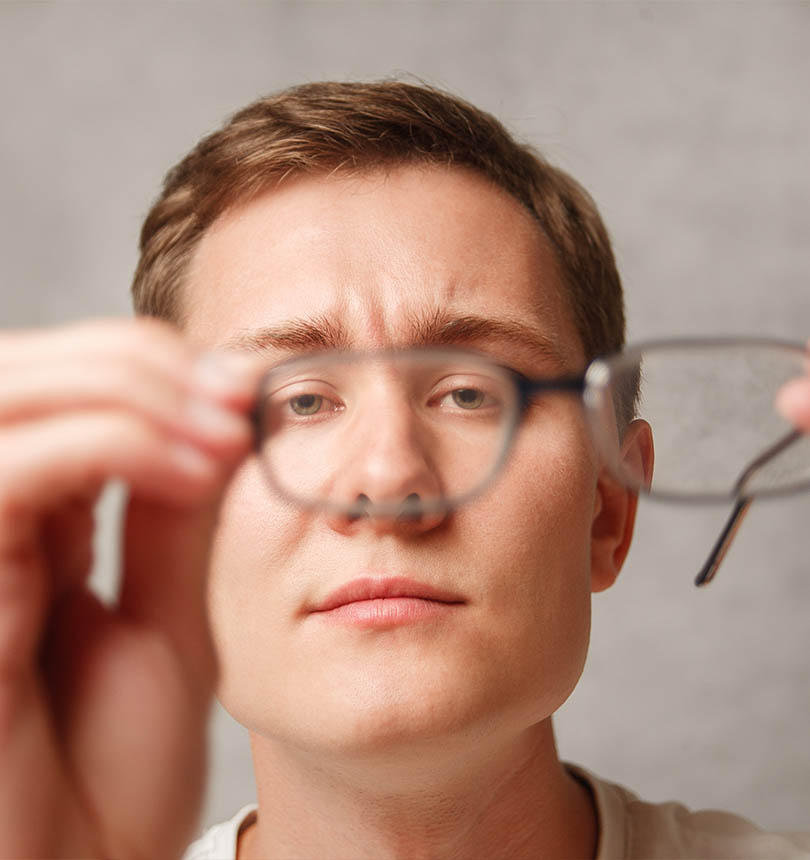
As we grow older, our eyesight changes, and we may need bifocals or progressive lenses to get the most out of our vision without having to carry around multiple pairs of glasses. If you need more than one set of glasses to see, you may be wondering, ‘Which is better: progressive or bifocal lenses?’ And that depends on what kind of lenses you want and what is best for your lifestyle.
Let’s take a look at the differences between progressive and bifocal lenses to help you decide which is right for you.
Bifocals correct just two types of vision problems.
Very simply, bifocal spectacles will help you see objects far away and close up, with no middle ground. While bifocal lenses used to have a visible line separating the near and distance prescriptions, they now come with an invisible, seamless transition between two distinct focal areas.
Traditional bifocals have the near prescription on the bottom of the glasses (or contacts) to aid in reading and other near-work activities. The distance prescription is on top for looking at far away objects in front of you or above the line of sight. Some bifocals, however, have the near prescription at the top as well as the bottom of the glasses, with the distance prescription in the middle. These are best for people who frequently need to look up or overhead at nearby objects like librarians and electricians.
There are different shapes of bifocal lenses that can help you get the most out of your prescription. Some of these include:
Progressive lenses provide multiple powers of vision correction.
Progressive lenses and trifocals are both types of multifocal vision correction. These are a good choice for people who need glasses or contacts to improve distance, intermediate and near vision. Similar to bifocals, trifocals offer three distinct focal areas even if there are no visible lines. Progressive lenses are different because rather than having distinct focal areas, they invisibly blend the areas between the multiple corrections and provide clear vision even in the
spaces between prescription strengths—similar to a ramp going up in magnification.
Progressive lenses are no-line multifocal eyeglass lenses that look exactly the same as single vision lenses. In other words, progressive lenses will help you see clearly at all distances without those annoying (and age-defining) "bifocal lines" that are visible bifocals and trifocals.
Progressive lenses are line-free multifocal that have a seamless progression of added magnifying power for intermediate and near vision.
The power of progressive lenses changes gradually from point to point on the lens surface, providing the correct lens power for seeing objects clearly at virtually any distance.
Bifocals, on the other hand, have only two lens powers — one for seeing distant objects clearly and a second power in the lower half of the lens for seeing clearly at a specified reading distance. The junction between these distinctly different power zones is defined by a visible "bifocal line" that cuts across the centre of the lens.
Progressive lenses sometimes are called "no-line bifocals" because they don't have this visible bifocal line. They have a significantly more advanced multifocal design than bifocals or trifocals.
Most people start needing multifocal eyeglasses sometime after age 40. This is when a normal aging change in the eye called presbyopia reduces our ability to see close objects clearly.
Progressive lenses also are the lens of choice for anyone who needs corrective lenses to see distant objects clearly (due to near sightedness, farsightedness and /or astigmatism) and for those who are presbyopic.
For anyone with presbyopia, progressive lenses have significant visual and cosmetic benefits compared with traditional bifocals and trifocals.
As already mentioned, bifocals have just two powers — one (in the top half of the lens) for distance vision, and a second (in the lower half of the lens) for near vision.
Trifocals go one step further — they have a third power for seeing objects clearly at arm's length. This "intermediate" power of a trifocal lens is located in a thin horizontal zone between the distance and near power zones.
Progressive lenses, on the other hand, have many more lens powers than bifocals or trifocals, and there's a gradual change in power from point to point across the surface of the lens.
The multifocal design of progressive lenses offers these benefits:
A professional optician can help you select the best progressive lens brand and design for your eyeglass prescription and your unique visual needs.
Your optician can also give you helpful tips on how to quickly become accustomed to wearing your new progressive lenses and how to care for your eyeglasses to continue seeing clearly. Also, for the best clarity, comfort and protection in all lighting, ask your optician about adding anti-reflective coating and photochromic lens treatment to your new progressive lenses.
Ready to start seeing better? It starts with an eye exam to update your prescription and then a visit to your eyewear retailer or shopping for glasses online.
Do you rub your eyes frequently, feel the strain in your eye as you sit for hours in front of the screen? Does your job demand that you keep piercingly look at the screen?
Covid has altered our lifestyle completely. The wo
As we grow older, our eyesight changes, and we may need bifocals or progressive lenses to get the most out of our vision without having to carry around multiple pairs of glasses. If you need more than one set of glasses to see, you may be wondering, ‘Which is better: progr
The word "polarized" is something we've seen everywhere in the world of eyewear. Often, it means a pair of sunglasses is more expensive than its non-polarized counterpart. But what does "polarized" actually mean? And what are the benefits of having a pair of polarized vs non